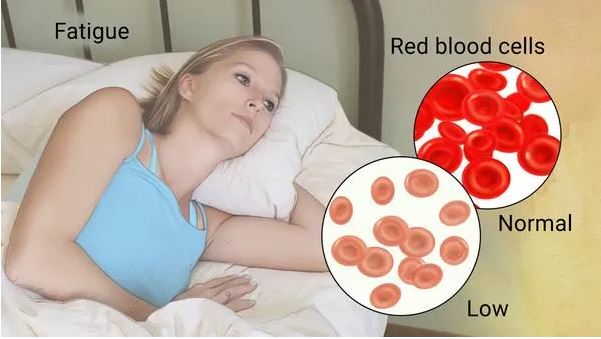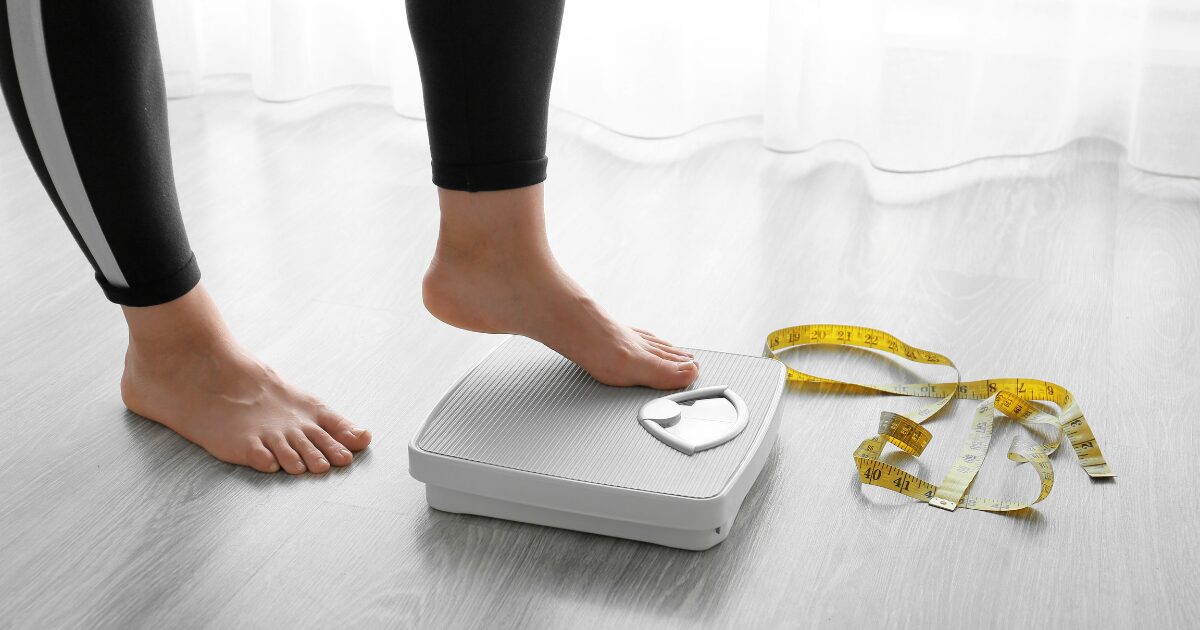Iron deficiency is a state of the human body where the healthy red blood cells are lesser than the normal range. Almost 25 percent of the whole world’s population have Anemia and you must be aware of the fact that Iron-deficiency is one of the biggest causes of anemia.
It develops in three different stages and each stage has its own specific level of red blood cells and iron stores. The first stage is the storage depletion stage in which iron stores are depleted. The 2nd stage is mild deficiency and the final stage is anemia.
You must understand the different stages of iron-deficiency to treat them well. It can be treated with the help of professional doctors. This guide is for you if you really want to know how iron-deficiency anemia develops in stages what are its main causes and how you can identify it.

Stages Of Iron Deficiency
When you don’t have enough iron stirred in your body then you are iron deficient and it can develop in 3 stages.
Stage 1: Storage Depletion
When we say that we have iron in our bodies, it does not mean that there is actual metal in them, but our bodies store iron in the form of ferritin.
So when the ferritin levels in the blood go lower than the normal range of iron in the body, it means that iron stores are decreasing and it is the first stage that leads to iron-deficiency in the body. In this stage, the serum ferritin level is decreased to less than 30 ng/mL (< 67.4 pmol/L).
In the first stage of deficiency infants and children including adolescents, pregnant women and people with gastrointestinal disorders are more in danger of storage depletion. The general indicators of stage 1 iron-deficiency are weakness and fatigue.
Detection Methods For Stage 1
- Serum ferritin test (low levels indicate depletion)
- Complete blood count (CBC) for anemia indicators
Stage 2: Mild Deficiency
In the second stage, iron-deficiency starts affecting red blood cells and there is not enough iron to support the formation of healthy red blood cells. In our body, iron is transferred from one part of the body to the other parts.
But as the body enters the second stage of deficiency, the level of transfer of iron lowers, and transferrin decreases which indicates that there is a mild deficiency in your body. Most athletes are at this stage because they require more iron than a normal person.
Here in the 2nd stage, the serum iron decreases to less than 50 mcg/dL (< 9 micromol/L) and transferrin saturation less than 16%. People with chronic illnesses are more prone to mild deficiency of iron. If you are always feeling dizzy and have shortness of breath with pale skin then it is indicated that you might be at the 2nd stage of deficiency.
Detection Methods For Stage 2
- Serum iron test (lower levels)
- Total iron-binding capacity (TIBC) test (higher levels)
- Transferrin saturation test (lower percentage)
Stage 3: Iron Deficiency Anemia
In the third stage, your hemoglobin levels begin to drop from the normal levels, which are typically 12 to 15 grams per deciliter for women and 14 to 16.5 grams per deciliter for men, although this range can slightly vary for athletes living at higher altitudes.
This is the final stage of deficiency where we can say that you have Iron-Deficiency Anemia (IDA). At this point, your red blood cells are very low and smaller, and they contain less hemoglobin.
Anemia has some symptoms like severe fatigue, cold hands and feet, and pica. It is the last and most severe stage of iron-deficiency where your body is unable to produce healthy red blood cells which can adversely affect your overall health and energy levels.
This is the final stage where, microcytosis, hypochromia, and functional iron-deficiency occur. Here microcytosis means that the red blood cells are becoming smaller than the normal size and then after that hypochromia will occur where RBCs turn pale or yellow in colour.
In the last level of stage 3, functional deficiency occurs where the problem begins to affect tissues in our body and it leads to some clinical symptoms and signs.
Detection Methods For Stage 3
- Hemoglobin test (low levels)
- Hematocrit test (low levels)
- Peripheral smear (microcytic, hypochromic red blood cells)
- Reticulocyte count (may be low)
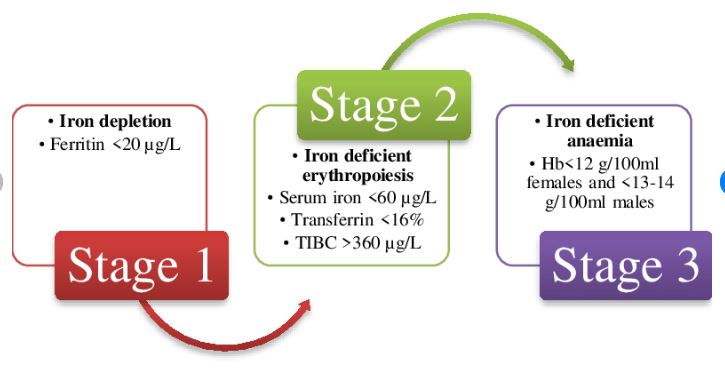
Who’s Likely To Develop Iron-Deficiency Anemia?
The most common cause of iron-deficiency anemia is blood loss. Usually, anyone in the world can develop anemia but it is more likely to develop in women who have menstrual cycles and are pregnant than men, there are some people who are always has risk of getting iron deficient, here are a few of them:
- Infants between the age group of 6 months to 12 months are in more danger because their iron depletes after 4 to 6 months and then after that, if they are given only breastmilk or unfortified milk they can have iron-deficiency.
- Many children between 1 to 2 years of age can also have an deficiency if they are only drinking cow’s milk. According to a study by the National Institute of Health, cow’s milk makes it harder for the body of a child to absorb iron.
- Adults who are more than 65 years of age can develop it because at this age they can’t eat a lot of food and thus they can develop anemia.
- Pregnant women are also at high risk of iron-deficiency. If a woman’s iron intake does not meet these increased needs, she can develop anemia, which can affect both her health and the baby’s development.
- Some people with some specific medical issues like peptic ulcers, colorectal cancer, and chronic kidney disease can cause chronic blood loss, leading to anemia.

How To Treat Anemia?
Thanks to the advanced medical sciences there is a treatment for anemia. When it comes to its treatment, there are two approaches used for it. The oral supplemental iron and the parenteral iron.
Identifying the cause of anemia is very important before treatment because there might be an issue that can be ignored if the cause is not identified. There could be an issue like a bleeding spot that needs attention first.
Oral Supplemental Iron
In the process of treating iron deficiency with oral supplemental iron, there are some salts that are used as medicine. These iron tablets are used as supplements to increase the level of iron. You can usually take those medicines which are prescribed by your healthcare provider.
This therapy of oral iron should continue for at least 5-6 months after your hemoglobin levels return to normal, it is just to make sure that your body’s iron stores are restored. Iron supplements have some side effects too, they can cause constipation and can turn your poop look dark-colored.
When you start taking the oral supplementals then you’ll notice the improvement in symptoms in a few weeks, but remember that it can take some months to restore all of your iron needs.
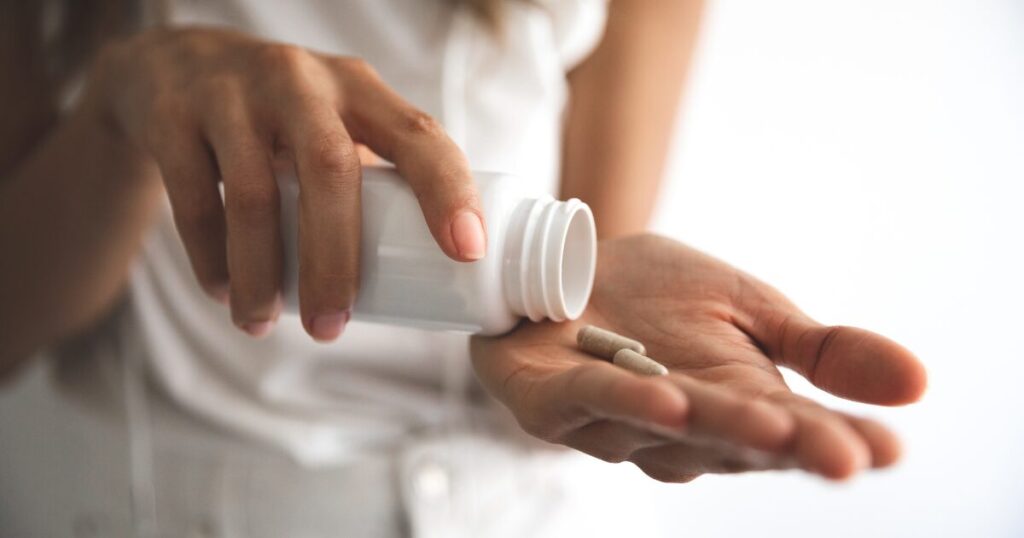
Parenteral Iron
If you want a speedy recovery, then parenteral iron is for you because it is usually injected into your body with a syringe, and it can work more quickly than oral supplemental iron but it comes with some risks that you can’t ignore. It can cause an allergic reaction in your body and can also have some side effects like fever, joint pain, or muscle pain.
How To Treat Iron Deficiency With Organic Food?
You can easily treat iron’s deficiency with the help of iron-rich organic foods and mostly, iron is present in beef, poultry, and meat but if you are a vegan then there are a lot of other options available for you.
Dark leafy greens, nuts, dried fruit, fresh fruits, and chocolates are also sources of iron. If dietary changes alone are not enough, consult a healthcare provider about taking iron supplements.
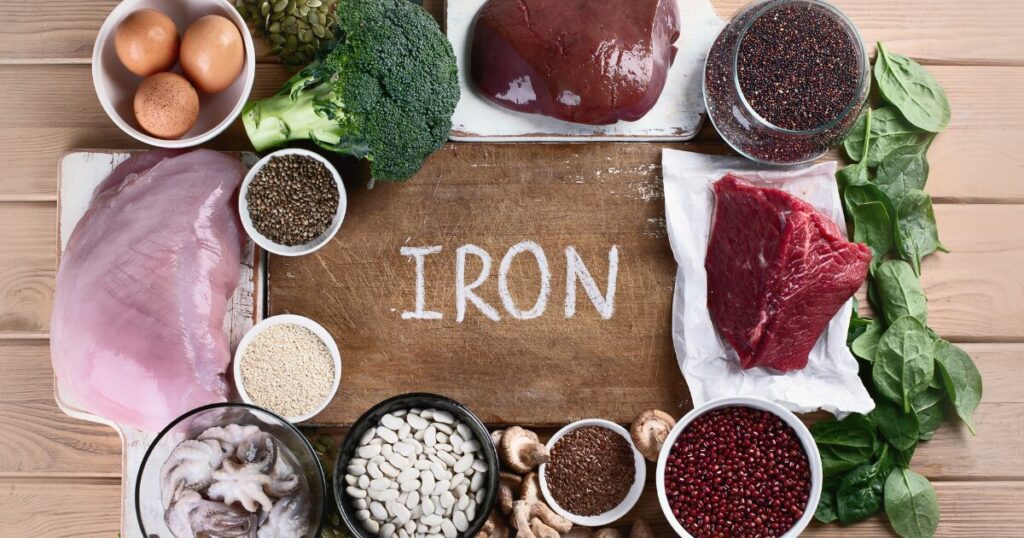
Final Words
There are 3 stages of Iron deficiency and the last stage develops anemia. Anemia can happen when your body consumes less iron from the food you eat. If you have last-stage, it can cause a lot of health issues.
Talk to your doctor immediately, if you observe any of the symptoms. Its treatment is very simple, you just have to eat supplements or you can eat iron-rich organic foods.
It’s extremely important to get health check-ups regularly from your doctor. They can check your iron levels and monitor your overall health for any issues. If you still have any queries related to iron deficiency then you can ask here in the comment section.
Which Organic Food is Best to Treat Iron Deficiency?
Have you ever deal with anemia? If yes, how do you recover from it? Do you prefer oral supplements or organic foods to treat anemia? Tell us based on your experience. Share your story in comment section or contact us here.
Frequently Asked Questions
What Is Serious Iron Deficiency?
Serious iron deficiency means that you are suffering from anemia. It occurs when the iron level lowers than a normal range to the point that it is unable to produce healthy red blood cells.
What Is The Final Stage Of Iron Deficiency?
The final stage of Iron deficiency is also known as anemia. In this stage, your body lacks iron and is unable to produce an adequate amount of hemoglobin which is very crucial for the normal functioning of the body.
How To Increase My Ferritin Levels?
If you want to raise your Iron level fast, then you need to increase the intake of foods that are rich in Iron like fish, beans, red meat, green leafy vegetables, tofu, and Iron-fortified cereals.
What Happens When Your Iron Is Way Too Low?
When your Iron is extremely low than normal range, it can lead to great health complications. You may experience dizziness, shortness of breath, chest pain, fast heartbeat, cold hands and feet, extreme tiredness and very pale skin.
What Drains Iron From Your Body?
There are a couple of factors that can drain Iron from your body. It includes blood loss, pregnancy, heavy menstrual periods, low-iron diets, frequent blood donations, and certain medical conditions like cancer or celiac disease.
Does Blood Loss Cause Iron Deficiency?
Yes, Iron deficiency is diagnosed in those people who have a lot of blood loss, maybe they donated blood or there may be an injury due to which blood can be lost. Also, microcytic anemia and Pica are the most prominent indicators of iron deficiency.

